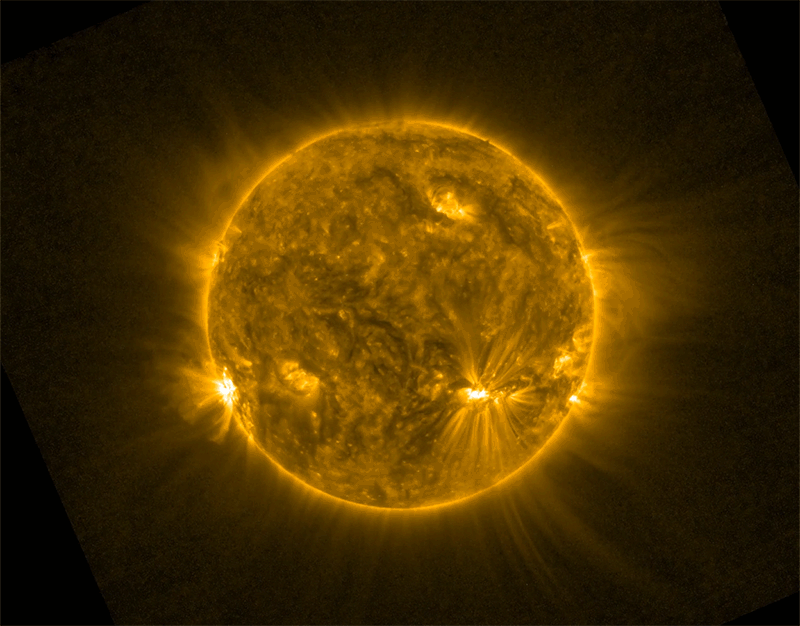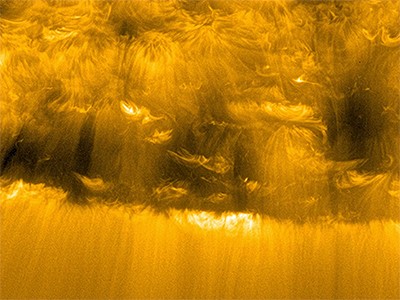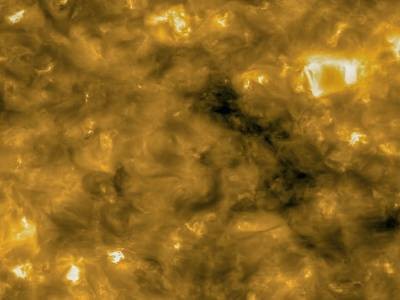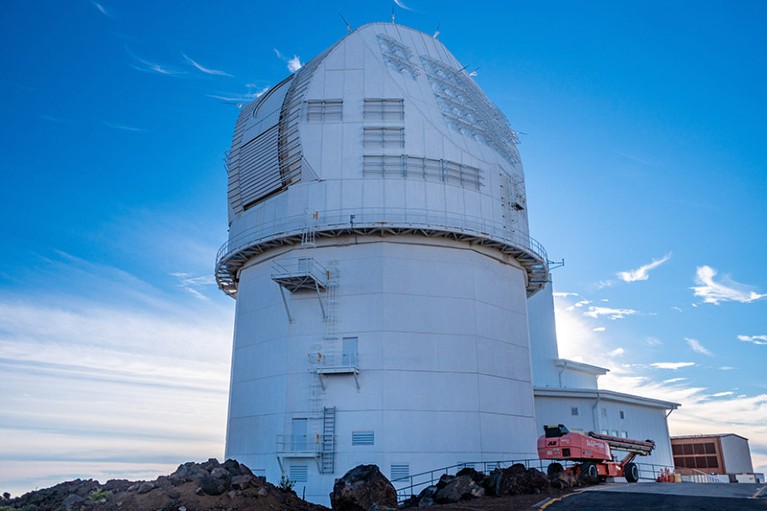

A snakelike disturbance of relatively cool plasma rippled across the Sun before a huge eruption of superheated gas in September 2022.Credit: ESA & NASA/Solar Orbiter/EUI Team; acknowledgement: Frédéric Auchère, IAS
In August last year, the Sun began to throw a tantrum. Clusters of dark spots appeared on its face, marking regions where magnetic fields were knotting and twisting its surface. By early September, some of these sunspots had rotated around to the far side of the Sun — and let loose an enormous belch of superheated gas. This huge eruption raced outwards, engulfing a US$1.5-billion spacecraft that was orbiting nearby.
That craft, NASA’s Parker Solar Probe, remained remarkably unscathed, and was even able to take unprecedented measurements as the solar blast washed over it. From nearby, a second spacecraft — the European Space Agency’s Solar Orbiter — watched the entire drama unfold. Never before have space missions seen so much activity so close to the Sun.

What powers the Sun’s mysterious wind? A daring spacecraft has some answers
What these probes have found, in this and similar moments over the past few years, is rewriting much of what scientists know about the Sun. Working in tandem, the spacecraft have observed massive solar eruptions, a slithering magnetic ‘snake’ on the Sun’s surface, and heat and energy rippling slowly through the Sun’s atmosphere. “We are living in a paradigm-shifting moment for this field,” says Dan Seaton, a solar physicist at the Southwest Research Institute in Boulder, Colorado.
It’s a fortuitous time to have these spacecraft so close to the Sun, because the star is hurtling towards the peak of its 11-year cycle of activity. The current solar cycle is already stronger than the last one; there were 163 sunspots on the Sun’s surface in June 2023, the most in more than two decades. August also brought several X-class flares, the largest type possible. “We’re definitely getting close to maximum if we’re not there already,” says Katharine Reeves, a solar physicist at the Harvard–Smithsonian Center for Astrophysics (CfA) in Cambridge, Massachusetts.
Powerful storms
Solar storms can send waves of energetic particles washing over Earth, where they can disrupt communications and knock out power grids, even as they form beautiful glowing aurorae over the poles. In February 2022, the aerospace company SpaceX lost 38 of 49 newly launched communications satellites when a solar storm caused Earth’s atmosphere to increase in density, creating extra drag on the satellites and pulling them out of orbit1.
To better understand the Sun’s activity and predict its effects on Earth, researchers have built various solar observatories over the years. Many have been in Earth orbit, whereas others have been stationed between Earth and the Sun or off that line, to get a better perspective on what storms might be incoming. For instance, India’s Aditya-L1 solar observatory, which was launched in September, is headed to a point part way between the Sun and Earth, where it will join two 1990s-era missions that monitor the Sun for Earthbound solar storms.
But not until the Parker Solar Probe launched in 2018, and the Solar Orbiter in 2020, did humanity start to get a close-up view of Earth’s home star. The two missions were conceived of independently and carry different types of instrument, but they work well together, Reeves says. Parker Solar Probe is on a looping trajectory that takes it closer to the Sun over time, allowing it to skim through the solar atmosphere and measure particles and magnetic fields at closer range than any spacecraft ever has. Solar Orbiter flies on a more distant orbit, but it has high-resolution cameras that can reveal bright solar flares, tiny plasma jets and other solar details.

Solar Orbiter captured a giant solar eruption on 15 February 2022.Credit: Solar Orbiter/EUI Team/ESA & NASA
Occasionally, their operators will coordinate the crafts to work in concert. For instance, mission managers realized that the spacecraft would be in an especially interesting alignment in June 2022. “We thought, OK, that’s worth asking for a particular mini campaign, and asked the engineers to roll the spacecraft, because only then would we get Parker Solar Probe just into our field of view,” says Daniel Müller, the project scientist for Solar Orbiter at the European Space Agency in Noordwijk, the Netherlands. So Solar Orbiter rolled to the side, both spacecraft made observations and scientists ended up with the first measurements of how quickly the temperature rises from the Sun’s surface into its atmosphere2.

NASA spacecraft ‘touches’ the Sun for the first time ever
It’s the combination of the instruments on each spacecraft — and the unique geometry that occur when they are at different places near the Sun — that enables this new science to be carried out. Many researchers are particularly interested in using the two missions to track the earliest phases of solar eruptions. These happen when twisted magnetic fields in the Sun’s atmosphere suddenly snap into a different configuration. The reshuffling of magnetic energy often causes a huge burst of superheated gas to erupt into space. If these coronal mass ejections reach Earth, they cause geomagnetic storms that can damage satellites and power grids.
Another opportunity for joint observations came in April 2021, when Solar Orbiter captured an eruption of material from the far side of the Sun as it headed for Parker Solar Probe. Within hours, a wave of charged particles engulfed the NASA spacecraft. The measurements it made allowed scientists to track the eruption in unprecedented detail, illuminating how these eruptions begin and evolve. Tatiana Niembro, an astrophysicist at CfA, and her team reported these in August3. Solar Orbiter was able to identify the particular region of the Sun that erupted, and Parker Solar Probe took pictures of the coronal mass ejection before the eruption washed over the spacecraft — the first measurement of this type.
Even more exciting for solar physicists was the September 2022 solar eruption — one of the fastest and most energetic solar eruptions on record. Emerging from the far side of the Sun, it blasted material out at around 2,700 kilometres per second4. Had it hit Earth, it might have caused a geomagnetic storm close to the most powerful ever recorded, the Carrington Event of 1859 that caused auroras to glow at low latitudes and telegraph equipment to break down.
Snakes and ropes
In the run-up to the eruption, on 5 September 2022, a giant solar snake of plasma appeared in Solar Orbiter images, wiggling its way across much of the disk of the Sun. The structure was essentially a rope of gas that was cooler than its surroundings, tracing the outlines of a filament of the solar magnetic field.
Scientists thought that such magnetic ropes were linked with coronal mass ejections, because they often appeared right before an eruption. But Solar Orbiter was able to nail down the association. It showed how this rope formed and moved in the hours before the eruption, slithering along at around 170 kilometres per second5. “That was just fantastic information,” says Lucie Green, a solar physicist at University College London. “We haven’t captured something like that before.”

This photo of the Sun is the closest ever taken
Hours later, the region where the snake originated erupted in the massive blast, sending billions of tonnes of superheated gas racing into space. This slammed almost straight into Parker Solar Probe. Engineers had built the spacecraft to withstand such eruptions, but it was still a nail-biting few days until Parker was able to send an ‘all’s-well’ signal back to Earth.
Since then, scientists have been working their way through analysing observations of the eruption, which is one of the fastest ever measured. “The amount of details, the amount of complexity and also the violence of the event — we’ve never seen it before and it’s just impressive,” says Nour Raouafi, a solar physicist at the Johns Hopkins University Applied Physics Laboratory in Laurel, Maryland, and principal investigator for Parker Solar Probe.
Among other things, the probe watched the plasma sweep dust particles out of its way — information that can help space-weather forecasters to understand the forces that influence a solar eruption on its way to Earth6. From the spacecraft’s measurements, researchers also discovered that the eruption progressed in three stages over the course of two days, each with its own mix charged-particle and magnetic-field behaviour7. Two of those stages had been seen before in other coronal mass ejections, but the third — marked by low-density plasma washing over the spacecraft — was unlike anything previously observed.

The Daniel K. Inouye Solar Telescope on Maui, Hawaii.Credit: National Solar Observatory (NSO), AURA, NSF
There is also a third fresh source of solar measurements, which is just starting to produce results. On the Hawaiian island of Maui sits the four-metre Daniel K. Inouye Solar Telescope, the world’s largest solar telescope. It became operational in 2020, but is still working through technical issues and is often offline for engineering work. Whenever it can, the Inouye telescope observes at the same time as Parker Solar Probe passes close by the Sun, says Alexandra Tritschler, a senior scientist at the National Solar Observatory in Boulder.
Last year, as a proof of concept, researchers arranged the schedules so that Solar Orbiter studied an active region on the Sun at the same time as that area was coming into view for the Inouye telescope. The data are still being analysed, but the teams hope to repeat joint observations in the future, Müller says.
Solar researchers expect that the next few years will produce a bounty of discoveries. Solar Orbiter is due to continue operating for at least another seven years, with its orbit gradually becoming more inclined to that of the Sun so that it looks down more on the Sun’s poles than on its equator. Meanwhile, Parker Solar Probe’s closest pass through the Sun’s atmosphere is still to come, in December 2024. After that, if NASA decides to continue funding the mission, the spacecraft might continue to make more deep dives into the Sun.
“It’s unique,” Green says of the combination of the two missions. “We may never have it to this level again.”

